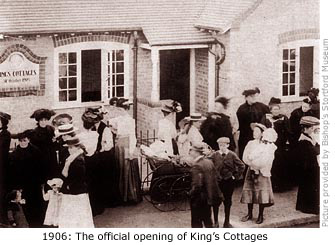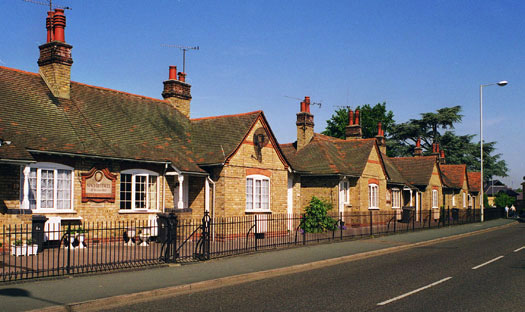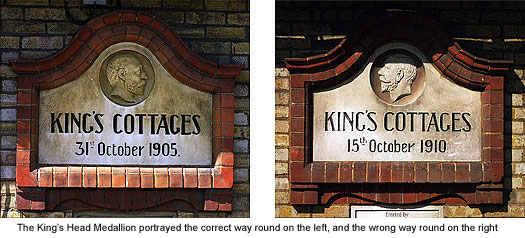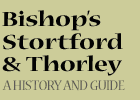|
In medieval times the monasteries had always tried to help the less fortunate among the population, but it was the Tudors, in particular Henry VIII (1509–1547), who made an attempt to deal with poverty. An Act of 1531 ruled that every parish had to keep its poor by means of charitable alms i.e. money given voluntarily by those most able to afford it.
Churchwardens’ accounts of 1547 show that William Norfolke paid 4d. (2p) rent ‘for Almshouse gardyn for half a yere’. The Almshouse mentioned was built for the poor of the town on the south side of the market place and is said to have later been replaced by five almshouses at Newtown in exchange for two tenements founded by Richard Pilston in 1572.
|
|
Almshouses were still being built for the benefit of the poor in the early 20th century and in Bishop’s Stortford, King’s Cottages fulfilled that role. Comprising of five blocks, the first two to be erected were funded by Sir Walter Gilbey in 1906 in memory of his wife, and named as such in recognition of his association with royalty.
 A third block, a gift of Admiral F. Vander Meulen, was built in 1907. He was the son of Rev Frederick Vander Meulen who for many years was Rector of Thorley, and it was because of this connection that the Admiral specified residents of Thorley should take priority to be housed in this block when any of the dwellings became vacant. The Admiral was also instrumental in arranging for a further block of cottages to be built in the name of his brother, Col. J.H. Vander Meulen. This was occupied by 1911. The fifth block, erected in 1915, was paid for by the Admiral’s sister, Mrs Georgina Menet, widow of the first Vicar of Hockerill’s All Saints church. A third block, a gift of Admiral F. Vander Meulen, was built in 1907. He was the son of Rev Frederick Vander Meulen who for many years was Rector of Thorley, and it was because of this connection that the Admiral specified residents of Thorley should take priority to be housed in this block when any of the dwellings became vacant. The Admiral was also instrumental in arranging for a further block of cottages to be built in the name of his brother, Col. J.H. Vander Meulen. This was occupied by 1911. The fifth block, erected in 1915, was paid for by the Admiral’s sister, Mrs Georgina Menet, widow of the first Vicar of Hockerill’s All Saints church.
Mounted on the front wall of each block of cottages is a large stone plaque commemorating the benefactor, but some embarrassment was caused when Admiral Vander-Meulin’s plaque was unveiled in 1907 to reveal the King’s Head Medallion had been represented the wrong way round.
Each block comprises of four cottages, two of which are single dwellings and the other two, double dwellings. When built, it was stipulated the single dwellings should be occupied by one female at a rent of 6d. (2 1/2p) per week, and that the double dwellings should house a man and his wife at a rent of 9d. (4p) per week.
Today the cottages serve much the same purpose, the only criteria for prospective tenants being that they should be aged over 55. Outwardly the buildings have changed very little since they were built, but the interiors have been totally refurbished and modernised to the highest standard.
Tenancy and upkeep is presided over by a Trust originally set up by Sir Walter Gilbey, who specified that only a direct descendant of his should always be one of the trustees to administer the cottages. His son, Tresham, served as Chairman of the Trustees from 1906 until his death in 1947, and Vincent Routeledge, the eldest son of Sir Walter Gilbey’s daughter, Mabe Kate, served until his death in 1967. The current family member associated with the Trust is Sir Walter's grandson, Walter Anthony Gilbey.
|
|
This club has been resident here since it was first formed in 1907. The land was initially rented from Sir Walter Gilbey, who became the club's first president, but when he died in November 1914 plans were put forward to acquire the freehold on behalf of the town. On Christmas Day that same year, the club signed a seven-year lease at a rent of £10 per annum.
First called The Havers Park Bowling and Tennis Club, provision was made for two grass tennis courts shortly after the green was laid, though these were later converted to hard courts. The green was relaid with Cumberland turf in 1931. To begin with the annual subscription was fixed at 12 shillings (60p) a year for bowlers and ten shillings (50p) for tennis players, and in its early days the club's membership was limited and exclusive, with only doctors, solicitors and the ‘well-to-do’ permitted to play. Women were excluded until 1935, and even then they could only play on certain days. Incredibly, they weren't allowed to even eat in the clubhouse until the 1990s!
The clubhouse has since been extended and modernised but the grounds remain much as they were when first laid out.
The Gilbey family always remained prominent at the club and it was their links with royalty that led to a visit, in May 1933, by HRH the Duchess of York (1901-2002), later Queen Elizabeth the Queen Mother. She came to the town to open a new wing of Rye Street Hospital, beforehand lunching with Tresham Gilbey and his wife at their home, Whitehall, then visited the bowls club where she watched a match between the London and Scottish Bowling Association and the Hertfordshire County Bowling Association. The Band of the Royal Caledonian School played Scottish airs while the match was in progress.
The club wrote to her when it celebrated its 90th anniversary, and she replied by saying she remembered the visit and sent a large photograph of herself at the club. This now takes pride of place on the clubhouse wall. Continuing their links with royalty, celebrations for the club's centenary in 2007 include a trip to Windsor Castle to play the royal household.
|





 A third block, a gift of Admiral F. Vander Meulen, was built in 1907. He was the son of Rev Frederick Vander Meulen who for many years was Rector of Thorley, and it was because of this connection that the Admiral specified residents of Thorley should take priority to be housed in this block when any of the dwellings became vacant. The Admiral was also instrumental in arranging for a further block of cottages to be built in the name of his brother, Col. J.H. Vander Meulen. This was occupied by 1911. The fifth block, erected in 1915, was paid for by the Admiral’s sister, Mrs Georgina Menet, widow of the first Vicar of Hockerill’s All Saints church.
A third block, a gift of Admiral F. Vander Meulen, was built in 1907. He was the son of Rev Frederick Vander Meulen who for many years was Rector of Thorley, and it was because of this connection that the Admiral specified residents of Thorley should take priority to be housed in this block when any of the dwellings became vacant. The Admiral was also instrumental in arranging for a further block of cottages to be built in the name of his brother, Col. J.H. Vander Meulen. This was occupied by 1911. The fifth block, erected in 1915, was paid for by the Admiral’s sister, Mrs Georgina Menet, widow of the first Vicar of Hockerill’s All Saints church.